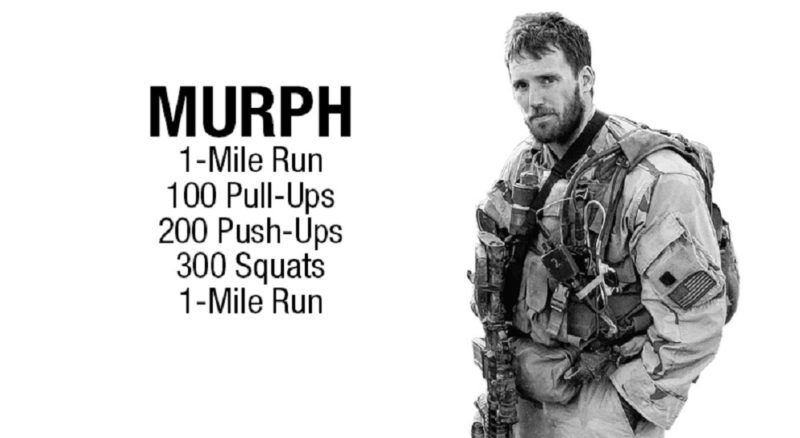- 1-mile run
- 100 pull-ups
- 200 push-ups
- 300 squats
- 1-mile run
Because it only contains bodyweight exercises, the workout appeals to calisthenics enthusiasts and athletes in other disciplines. Many people find the workout appealing as it is a well-rounded workout consisting of a pull exercise, a push exercise, an exercise that targets the legs, and fast-paced cardio.
An actual Murph workout should be completed using a weighted vest. The vest should weigh 20lbs, which is just over 9kg.
How long does it take to complete the Murph workout?
Does the Murph workout have to be done in a specific order? How is best to partition the exercises?
- 5 pull-ups
- 10 push-ups
- 15 squats
- …repeat 20x total
If you are particularly strong at squats, then you may benefit from trying to get them out the way earlier. If this is the case, then you may prefer the following variation:
- 5 pull-ups
- 10 push-ups
- 20 squats
- …repeat 15x total
- 5 pull-ups
- 10 push-ups
- …repeat 5x total
The advantage of breaking the workout down this way is that you’re much less likely to hit failure within a single set. I personally find pull-ups the hardest part of the workout, and completing sets of 5 pull-ups means I don’t usually hit failure until the later sets, which means I avoid building up lactic acid in my muscles.
Should you complete the Murph using strict pull-ups or use CrossFit-style kipping pull-ups?
I love the passion behind CrossFit and the variety of different workouts in the sport (especially the bodyweight ones), but I’ll never sacrifice form for speed during my own workouts. I couldn’t live with myself if I started performing kipping pull-ups 😉
So how does this differ? And to the beginner readers out there, what does this even mean?!
Kipping pull-ups refer to a pull-up technique which is common in CrossFit and uses a swinging motion to complete each rep (see the video below).
Correct form pull-ups, on the other hand, should be performed in a controlled manner, with the torso and legs remaining as still as possible throughout each rep, and the scapula disengaged fully at the bottom of each rep. More about this technique can be seen in our technique article “How to Achieve Your First Pull-Up: A Beginners Guide“.
I would fully expect the total time to be increased when performing correct form pull-ups, but just how much this increases by would be hard to say.
My recommendation would be that unless you’re training for or competing in a CrossFit competition, you should train using correct form pull-ups when completing the Murph.
What should I do if I’m unable to complete the full Murph workout?
Here are some tips I’d recommend for those of you who are struggling:
- Focus on completing the Murph without any added weight first
- Break down the reps into 20 different sets as previously suggested. Make a note of how many sets you can complete and use this number as your goal to beat. For example, if you can only complete 7 sets, then don’t beat yourself up about it. Instead, focus on hitting 8 sets next time. Once you hit 8 sets, aim for 9 sets. It’s all about baby steps!
- Try and understand which exercise is your weakest and concentrate on improving that outside of the workout
- Use assistance to help you if you have a weak area. I found I was struggling with the pull-ups at around the 15th or 16th set, so rather than giving up on the workout 3/4 of the way through I used a resistance band to help me complete the pull-ups
- Avoid overtraining. The Murph workout is best attempted when all of your muscles are fresh and not feeling sore. I would avoid attempting the workout any more than once per week
What other Crossfit bodyweight workouts are there that are similar to the Murph?
- Cindy
- Angie
- Tabata Something Else
- Barbara
- A Hope For Kenya
You can find more information about the above 5 CrossFit workouts here.

Founder of www.calisthenics-101.co.uk. Training calisthenics since 2012.
Currently working on: 30 second one-arm handstand, muscle-up 360, straddle planche.
